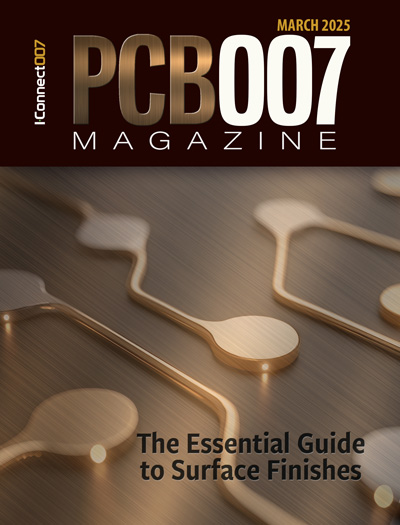-

- News
- Books
Featured Books
- pcb007 Magazine
Latest Issues
Current Issue
In Pursuit of Perfection: Defect Reduction
For bare PCB board fabrication, defect reduction is a critical aspect of a company's bottom line profitability. In this issue, we examine how imaging, etching, and plating processes can provide information and insight into reducing defects and increasing yields.

Voices of the Industry
We take the pulse of the PCB industry by sharing insights from leading fabricators and suppliers in this month's issue. We've gathered their thoughts on the new U.S. administration, spending, the war in Ukraine, and their most pressing needs. It’s an eye-opening and enlightening look behind the curtain.

The Essential Guide to Surface Finishes
We go back to basics this month with a recount of a little history, and look forward to addressing the many challenges that high density, high frequency, adhesion, SI, and corrosion concerns for harsh environments bring to the fore. We compare and contrast surface finishes by type and application, take a hard look at the many iterations of gold plating, and address palladium as a surface finish.
- Articles
- Columns
Search Console
- Links
- Media kit
||| MENU - pcb007 Magazine
Happy Holden Book Excerpt: CIM & Automation Strategy
May 22, 2020 | Happy Holden, I-Connect007Estimated reading time: 2 minutes
The following is an excerpt from Chapter 1 of Happy Holden’s I-Connect007 eBook Automation and Advanced Procedures in PCB Fabrication. In this book, Happy explains fabrication automation with illustrative examples and anecdotes from his decades as a mechanization leader.
Chapter 1: CIM & Automation Strategy
There's a lot of talk about automation, but I find that there is very little available on automation planning. This is one of my specialties. I started by studying for an MSEE in control theory. This went well with my bachelor’s degree in chemical engineering, because I specialized in process control and IC manufacturing.
This led me to take my first job at Hewlett-Packard. They wanted to automate their IC production line, even back in 1970. I discovered there were many companies offering equipment and software, but few had a strategy for how to automate. So we developed a methodology that has worked for very well over the years. In the next chapter, I will focus on computer-aided manufacturing and the connectivity issues with different protocols and available software.
Remember, the benefits will be derived only if certain cardinal principles are observed. This chapter briefly outlines the background of computer-integrated manufacturing (CIM) and six automation principles: superiority, simplicity, flexibility, compatibility, manufacturability, and reliability.
Introduction
The characteristics of successful automation application in manufacturing depend on how well business and technical management understand and promote the strategies, tactics, and philosophies used in modern manufacturing. Successful automation implementation can be enhanced in any company, small or large, by reviewing philosophies of CIM, automation, managements roles, mechanization, SPC, TQC, Lean, MRP and design for manufacturing.
Computer-Integrated Manufacturing (CIM)
The strategies outlined here are considered CIM, which HP was once in the business of selling. HP called it “The Manufacturers Productivity Network,” or MPN. These products included various software, computer, networking, interface, and measurement systems.
At that time, HP had been in the business longer than any other company. It started with government and other requests for automated test and measurement systems. Because of the need to automate various measurement instruments and systems, HP created the first machine-to-machine protocol called HP Interface Bus (HP-IB). This was later formulized into the IEEE-488 Communication Standard.
HP needed an instrument controller, so they purchased a unique 16-bit computer architecture from Union Carbide, which became the HP2116A in 1964. This computer was unique because the operating system was real-time, interrupt-driven, and had space for 16 interface cards for measurement instruments. What HP did not realize was that many companies were using the computer not with instruments, but with multiple input terminals and printers, creating the first time-share systems. Thus, HP created a smaller and lower-cost version called the HP2114A. This led to the world’s first time-share system, the HP2000.
To download Happy's free eBook from the I-Connect007 library, click here, or to order your print-on-demand copy, click here.
Check out all of the free eBooks in the I-Connect007 Library, covering PCB design, fabrication, assembly, and much more.
Suggested Items
Orbel Corporation Integrates Schmoll Direct Imaging
06/04/2025 | Schmoll AmericaOrbel Corporation in Easton, PA, proudly becomes the first PCM facility in the U.S. equipped with Schmoll’s MDI Direct Imaging system. This installation empowers Orbel to support customers with greater precision and quality.
GlobalFoundries Announces $16B U.S. Investment to Reshore Essential Chip Manufacturing and Accelerate AI Growth
06/04/2025 | GlobalFoundriesGlobalFoundries, working with the Trump Administration and with support from leading technology companies aiming to onshore critical components of their supply chain, announced plans to invest $16 billion to expand its semiconductor manufacturing and advanced packaging capabilities across its facilities in New York and Vermont.
Catching Up With AMI EMS President Greg Boyd: Our People Make the Difference
06/04/2025 | Dan BeaulieuI’ve had the privilege to work with countless companies in the electronics manufacturing space, but few have impressed me as deeply as Alternative Manufacturing Inc. (AMI). Based in Winthrop, Maine, AMI is a 100% employee-owned company that embodies the very best of what American manufacturing can be. AMI sets itself apart by its unwavering commitment to quality, transparency, and partnership.
ZETWERK Enhances Manufacturing Capabilities with TRI
06/04/2025 | TRITest Research, Inc. (TRI), the leading test and inspection systems provider for the electronics manufacturing industry, is pleased to announce that ZETWERK Electronics has integrated TRI's Automated Optical Inspection (AOI) and Solder Paste Inspection (SPI) solutions into its state-of-the-art manufacturing facility in Tamil Nadu.
Rehm Thermal Systems Mexico: Ten Years of Growth and Innovation in an Emerging Market
06/03/2025 | Rehm Thermal SystemsOver ten years ago, Luis A. Garcia began his success story at Rehm Thermal Systems. On May 15, 2013, he initially joined as a member of the Rehm USA team.


